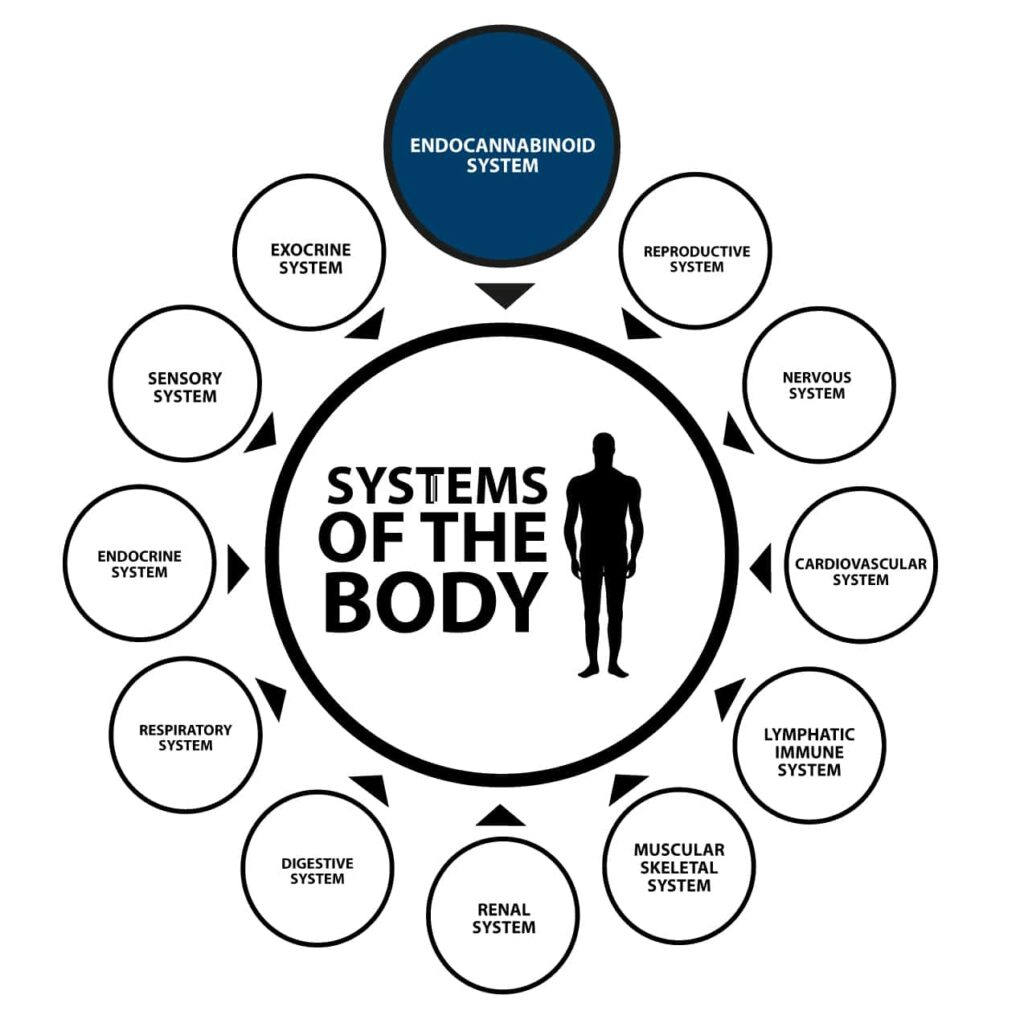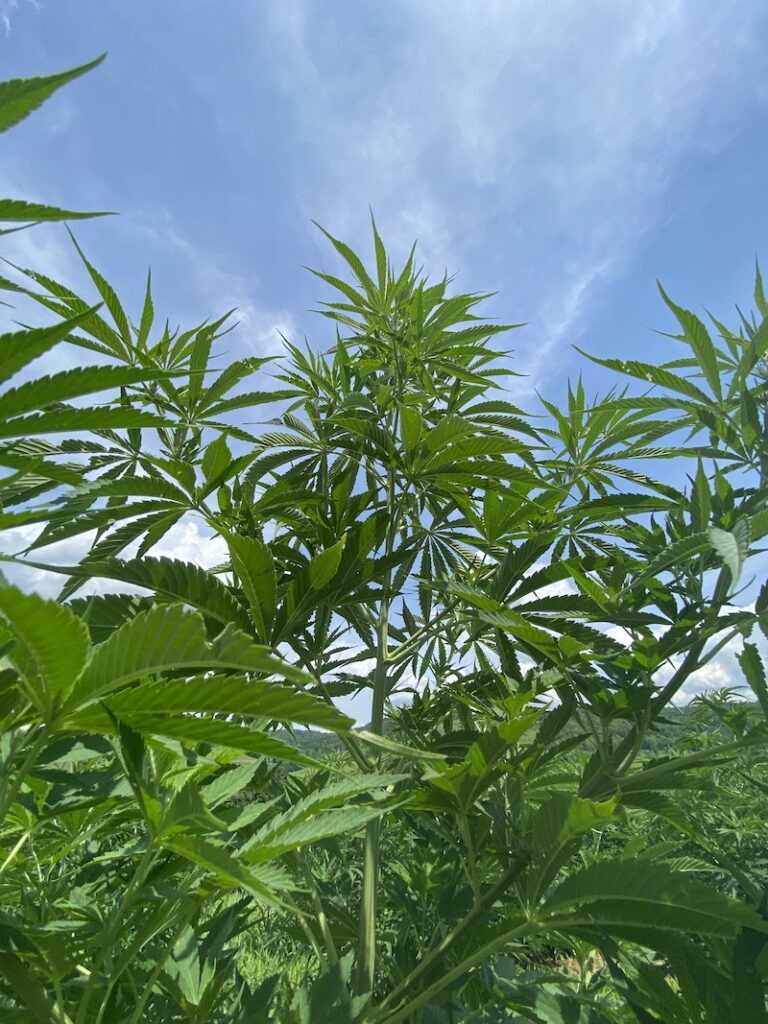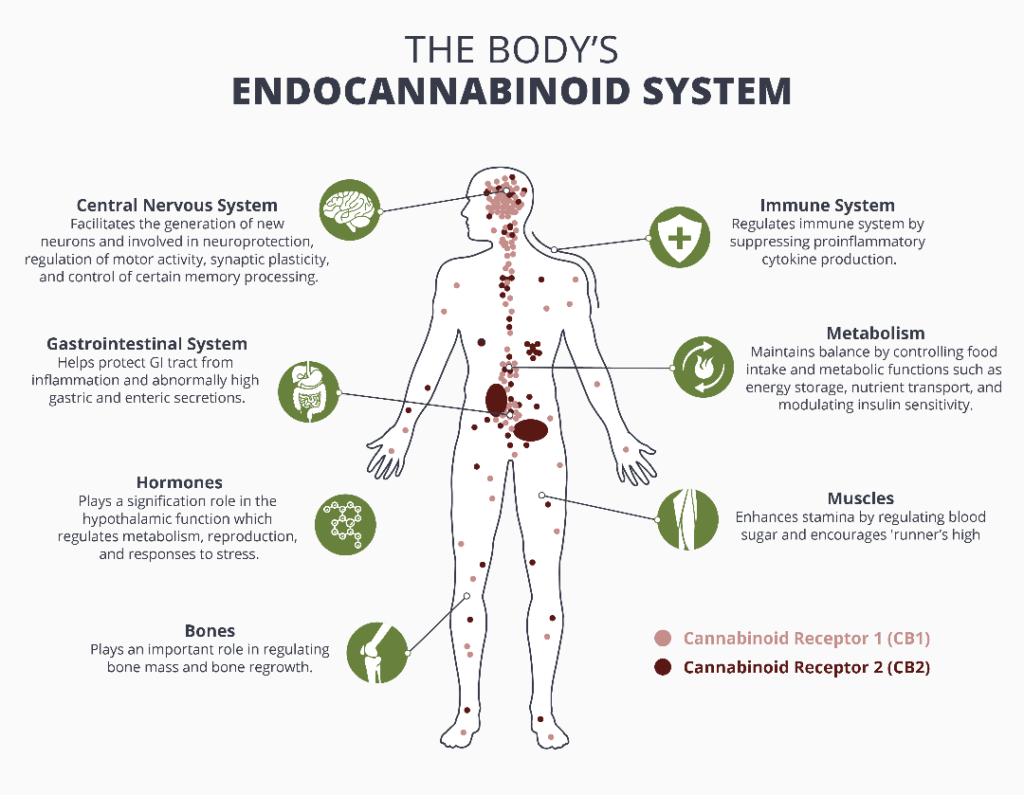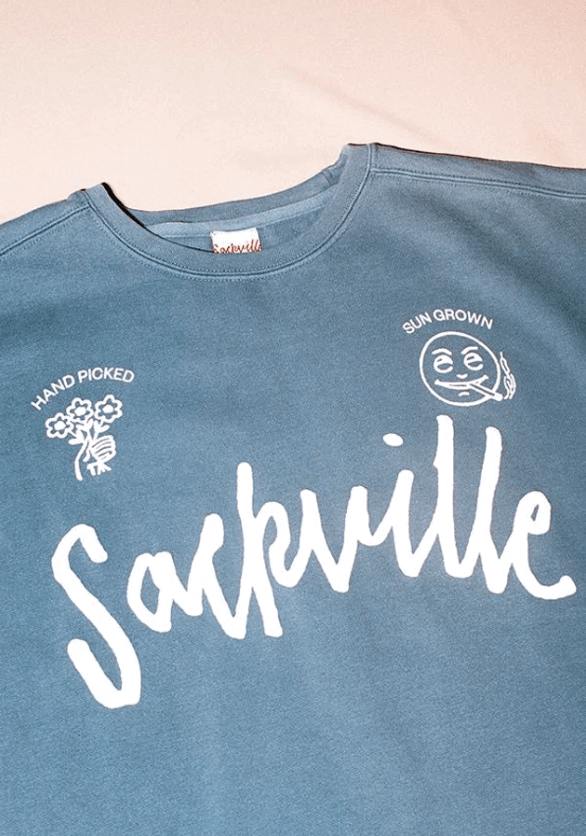Quick Intro to the Endocannabinoid System
What is the Endocannabinoid System and How Does CBD Support it?
Going to school you probably learned the major health systems – skeletal, muscular, nervous, endocrine lymphatic, digestive system, circulatory, respiratory, urinary, reproductive, and integumentary (are we bringing up flashcard nightmares for you yet?)
There’s one that your science teachers may have left out, and that’s the Endocannabinoid System. We’d be willing to guess that, unless you’re an avid cannabis user or in the cannabis industry, you probably don’t know much about it. The lack of knowledge and understanding around the Endocannabinoid System is an even greater shock when hearing it be described as the most important physiologic system involved in establishing and maintaining human health.
This powerhouse system was discovered in the 1990’s when scientists were trying to figure out how THC (the primary psychoactive component of cannabis) impacted the human body. What they discovered was a complex network of cannabinoid receptors (CBR) expressed in cells of both the central and peripheral nervous system.
The body contains two types of naturally-occurring cannabinoid receptors: CB1 and CB2. CB1 receptors are located in the brain and throughout the body, while CB2 receptors are found mostly in the immune and gastrointestinal system. Endocannabinoid receptors are the most abundant neuromodulatory receptors in the body.
” It’s best to think of it like a sort of bridge: A bridge between the mind and body and between various organ systems”
via CBDcentral.com
Discovering this system prompted the next question: if there are receptors for these chemicals in our bodies, then shouldn’t our bodies produce these chemicals to bond with the receptors? The answer: yes!
Our bodies naturally produce endocannabinoids, such as Anandamide and 2-AG. Endocannabinoids are produced by our own bodies and act upon the receptors of the endocannabinoid system in different ways, all in the interest of creating beautiful physiological harmony.
The only probelm is that endocannabinoids degrade quickly in our bodies and often times the average ECS is in need of some extra attention to operate at 100%. Enter phytocannabinoids: cannabinoids that are produced by plants (most notably, cannabis). Phytocannabinoids have the same ability to act upon the receptors of the Endocannabinoid System, or in the case of CBD, indirectly act upon ECS receptors by allowing for more of the endocannabinoid Anandamide to stay active in our system.
Why does that matter?
Phytocannabinoids binding to the cannabinoid receptors in our bodies, or enhancing the activity of the endocannabinoid we produce ourselves, means a more receptive, toned and balanced Endocannabinoid System.
The Endocannabinoid System is like an orchestra conductor, and each physiological system/function is its own musician/instrument. The ECS is not only in charge of making sure each musician’s instrument is in-tune and working well on its own, it is in charge of making sure that, when all of the individual tones and melodies come together, they create beautiful music and not a cacophony.
That wonderful harmony is what we call homeostasis: the ideal state of balance that our bodies are always working towards maintaining.
The Endocannabinoid System Regulates Important Physiological Functions:
- Appetite
- Digestion
- Immune function; inflammatory response (including neuro-inflammation)
- Mood
- Sleep
- Reproduction/fertility
- Motor control
- Memory
- Pain
- Pleasure/reward
Most of the receptors in our ECS are concentrated in our gut and nervous system, two areas that set the tone for how the whole body is feeling. Ease or dis-ease is mostly a downstream function of gut health and nervous system activity. What’s happening through the gut-brain axis can largely dictate what’s happening in the rest of the body, so it makes sense that the maestro itself, the ECS, would need to be right there in the action
How Does CBD Work Within the ECS?
CBD is an amazing ECS activator and overall regulator. It is one of the many phytocannabinoids found in the cannabis plant, but there are a couple of really important things to know about CBD and, more specifically, its relation to THC.
- CBD doesn’t get you “high” like THC (the most commonly known phytocannabinoid).
- THC fits into the CB1 receptors of your ECS like a lock and key.
- THC’s ability to bind perfectly with the CB1 receptors in your brain cause the intoxicating effect that is often associated with cannabis.
- CBD not only doesn’t fit into those receptors, it actually acts as what is called a CB1 antagonist.
- Being an antagonist means that it blocks or inhibits activity at that receptor site; CBD can actually stop THC from binding to those sites and reduce the intoxicating effects of THC when the two are taken together.
CBD does not fit exactly into either CB1 or CB2 receptors. Instead, it stimulates both receptors and causes a reaction without binding directly, creating changes in cells that contain them. CBD activates over 65 molecular targets throughout our body, including the 5HT (serotonin) system TRPV channels which play a key role in mood/anxiety and pain/inflammation, respectively.
The primary manner in which CBD acts upon the Endocannabinoid System is by inhibiting an enzyme called FAAH. FAAH breaks down anandamide. Anandamide acts directly upon ECS receptors and play a major role in feelings of well-being. You know the runner’s high that has always been attributed to endorphins? Research has proven that it is actually an endocannabinoid release (specifically, an anandamide release) causing that rush of good feels.
CBD works similarly to SSRIs like Prozak or Zoloft or Lexapro in the way that it regulates serotonin activity. Serotonin is often referred to as the “feel good” neurotransmitter because it affects mood, sex drive, appetite, sleep, motivation and more. If our bodies are not producing enough serotonin, we experience anxiety and depression among a host of other potential issues. CBD and the ECS have the ability to assess activity at the receptor sites and relay their intel back to the pre-synaptic sites where the neurotransmitters are released.
This kind of communication between cells is called retrograde signaling and it is one of the many things that makes the Endocannabinoid System so truly special. We have only hit the tip of the iceberg when it comes to understanding the ECS, endocannabinoids and phytocannabinoids. There is still so much more to learn, but we are excited about learning it! Clinical research has the ability to validate the claims that cannabis consumers have been making around the plant for decades. It can shift the healthcare paradigm and give us a clear path towards acceptance of alternative medicines and plant-based healing.


 The Steady Supply
The Steady Supply

 Personalized Vibes
Personalized Vibes




